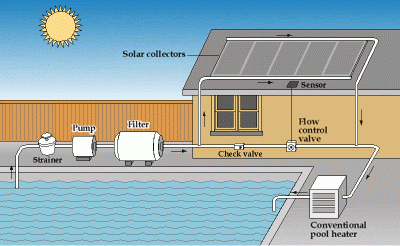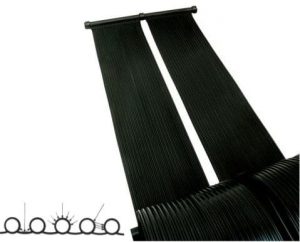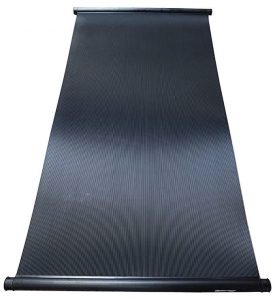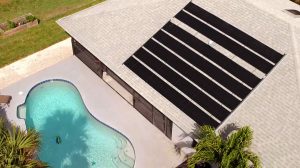Solar pools heaters are a great option for the swimming pool owner that needs a little extra heat in cooler months or even year round.
Not only do they extend your soaking season, but a solar pool heater can also help bring down your energy bills.
Their low annual operating costs (in other words, their free clean energy!) can mean solar pool heaters can be very cost-effective when compared to traditional gas heaters or electric heat pumps in the long run.
Let’s take a quick look at our four top picks for the best solar pool heaters in 2021 before we dive into more detailed reviews:
Top 4 Best Solar Pool Heaters for 2021
- XtremepowerUS – Best Solar Pool Heater Overall
- Fafco SunSaver – Most Efficient Solar Pool Heater
- GAME SolarPro Curve – Best Solar Pool Heater for Small Pools
- Smartpool SunHeater – Best Solar Pool Heater for Large Pools
Solar Pool Heater Reviews
Let’s take a better look at our favorite solar pool heaters.
XtremepowerUS Solar Panel Pool Heating System
Best Solar Pool Heater Overall
A low-cost solar heater for both in-ground and above-ground pools. Excellent price with great customer reviews.
Check Price at AmazonThe XtremepowerUS solar pool heater is designed for both above-ground and in-ground pools. It’s high review scores and extremely low cost means it’s the perfect solar pool heater for those just starting out in the renewable energy world.
First off, these bendable collectors are 28 inches by 20 feet long, for a total of 40 square feet. Quick connects allow for easy assembly. The collectors can be installed anywhere there’s ample space and sunlight, though at this size your roof is probably the best bet. Exactly how many collectors you need depends on the size of the pool and the manufacturer typically recommends between one and three.
Most customers praise the functionality of the kit, saying they work great on mild to hot days, even in northern Washington. One user noted that the water temperature will reach 90 to 100 degrees on days that see 80 degrees or higher. Other users note they kit has few leaks at connection points – a common issue with these cheaper kits.
Learn More & Buy Now at AmazonFafco SunSaver
Most Efficient Solar Pool Heater
One of the highest efficiency solar collectors for pools on the market.
Check Price at AmazonFafco claims these are the highest performing solar collectors on the market, as each collector contains 2x as many tubes as other solar pool collectors and the greater surface area can heat water more efficiently.
Unlike the other products on our list, Fafco’s SunSaver collectors are manufactured of rigid, UV-resistant polymer, so you can’t roll them up. They come in two different sizes – 4’ x 10’ and 4’ x 12’ – and contain a 2” header pipe for better flow and less strain on your pump.
While there aren’t too many reviews for Fafco online, it is one of the best-known brands in the solar pool heating industry and they back up their products with a fantastic 12-year warranty.
If you’re looking for reliable and ultra-efficient products, Fafco can certainly cover you, but keep in mind they are much more expensive than the many other options on our list.
Learn More & Buy Now at AmazonGAME SolarPro Curve
Best Solar Pool Heater for Small Pools
A compact, effective solar heater for smaller pools.
Check Price at AmazonThe GAME SolarPro pool heater is designed for above-ground pools and designed to gradually heat your pool to extend your season. The manufacturer says it should increase the water temperature in an 8,000-gallon pool by 5 degrees in four days.
Unlike most others on our list, this collector is rigid plastic with a unique curved design, which GAME says accelerates heating, and includes two adjustable legs to angle the collector towards the sun. Its total size is 43”x 27” (8 square feet) and weighs about 25 pounds, so it’s best for small applications and easy for a single individual to pick up and move.
The solar heater’s connectors are compatible with pools from a variety of manufacturers. Customers have used it on many pool types and report the heater works quite well. After a few days in the sun, users report the water temperature can climb to the high 80s and even low 90s. Some users even purchase several and hook them up in line for larger in-ground pools.
If you’re looking to extend your season, the SolarPro Curve is one of the best solar heaters for smaller or above-ground pools.
Learn More & Buy Now at AmazonSmartpool SunHeater
Best Solar Pool Heater for Large Pools
A large, cost-effective, solar pool heater for large pools. Great customer reviews!
Check Price at AmazonSmartpool’s SunHeater kit is the largest solar heater on our list and is designed for in-ground pools. In fact, it’s 2x as big as the others, making it one of the best solar heater for larger pools, as you’ll need less equipment and fewer connections that can suffer leaks. On top of that, these solar pool heaters are made in the USA!
Each collector is 4 feet wide by 20 feet long, for a total area of 80 square feet. The heater is made from flexible polypropylene and can be rolled up and stored if needed. Smartpool recommends varying numbers of heaters depending on the size of the pool:
- 15’ x 30’ (450 square feet): 2 heaters
- 16’ x 36’ (576 sf): 3 heaters
- 20’ x 40’ (800 sf): 4 heaters
The manufacturer says its solar water heaters raise water temperature by 6° to 10°, and customers corroborate this. Most say the heaters work as promised, though some of the components (like the included valves) are poor quality and should be replaced with higher-quality equipment from your local box store. Keep that in mind if you’re looking into this kit.
Learn More & Buy Now at AmazonSolar pool heaters: What are they and how do they work?

Put briefly, solar pool heaters collect sunlight to heat your pool’s water. A pump pulls water from the pool and sends it through a strainer and filter to remove any debris that could clog the system.
After the filter, the water is sent to the solar collectors. The solar collectors are the heart of the system. The collectors are thin rectangular panels, typically installed on your roof. Inside the collectors, the water runs through thin pipes – usually made of copper or plastic – where the sun heats it to the desired temperature. Once heated, the water is sent back to the pool (or an auxiliary heater if necessary) for you to relax and enjoy.
A flow control valve monitors your pool water’s temperature and diverts the water to the solar collectors when it dips below the set temperature. Alternately, if your pool’s water is too warm, it’ll stop sending water through the solar collectors.
As you can see, solar water heaters are actually pretty simple systems and only need four basic pieces of equipment to operate:
- Solar collector(s): Water is pumped through the solar collector, where it is heated by the sun
- Filter: removes debris in the pool water before being pumped to the solar collector. Typically a cartridge filter
- Pump: circulates the water through the system
- Flow control valve: the device that diverts the pool water through the collectors
In reality, that system can be far more complicated as you add auxiliary pool heaters, spa operation, suction valves, and return valves. However, all systems follow the basic set-up above.
How much do the best solar pool heaters cost?
The EPA gives a ballpark figure of $3,000 to $4,000 to install a solar pool heating system. This includes equipment and installation costs. The solar collectors themselves are the single biggest expense, costing about $400 each, though that price can go up or down depending on size and quality.
Obviously, the bigger the pool, the greater your heating needs are and the bigger your solar pool heater will need to be. Exactly how much your system will cost depends on your heating needs.
You can read more on sizing your solar pool heater in the section below.
How much can you save with a solar pool heater?
Once you’ve installed your solar heating system, heating your pool is absolutely free (unless you use an auxiliary heater).
In comparison, if you heat a 1,000 square foot pool with a gas pool heater, you can expect to pay about $1,500 to $3,600 a year, depending on your utility costs, location, and ambient temperature.
At this rate, the solar pool heater you paid $3k to $4k for would enjoy a payback of 1 to 3 years. In real life, that ROI could extend to 7 years or so if your utility costs are lower than most, you installed premium components that increased your installation costs, or you live in an area with less sunlight.
Replacement costs for solar water heaters are also low. Unlike heat pumps and gas heaters – which last about five years – solar heaters have no moving internal parts that wear out over time, so solar pool heaters generally last much longer. As long as there are no cracks, leaks, or equipment degradation, you’re good to go!
Financial savings aren’t the only benefits to solar pool heaters. In an effort to save money, many pool owners with gas heaters tend to turn on their heaters only when they want to swim. While not a huge issue, this does require a bit of planning beforehand. Solar pool heaters though are working anytime there’s daylight, so you can enjoy more spontaneous dips in the pool on a nice day!
Incentives help lower costs
You can shorten the time it takes to see a return on your investment by taking advantage of all available incentives to drop your total costs as much as possible.
Utilities, states, and cities across the US offer a variety of incentives to help drop the cost of renewable energy projects, including solar pool heating systems. While not all utilities and states offer these kinds of incentives (most don’t), you might get lucky and be eligible for one or several!
Incentives generally fall under three categories: rebates, tax incentives (both credits and exemptions), and loans. Here are a few examples of what’s out there and what you can expect:
- Rebates: Some utilities and cities offer rebates for installing solar pool heating systems. Dominion Energy in Utah, for example, offers a flat $750 rebate for both domestic and pool solar water heaters. The City of Longwood, Florida, will reimburse up to 10% of the cost of installing a solar pool heating system, up to $500 per year.
- Income Tax Credits: A few states offer personal income tax credits for solar pool heaters. Utah offers a tax credit worth 25% of your system cost, up to $2,000. Arizona offers a similar tax credit, at 25% of the installation’s cost, but only up to $1,000. You typically apply for these tax credits when filing your taxes, so it could be a few months before you see these benefits. Also, these tax credits are typically non-refundable, so you won’t get paid out if the tax credit is more than what you owe (though you can typically break down the credit and claim it over several years).
- Loans: Occasionally, utilities will offer low-interest loans for renewable or energy efficiency upgrades. Clark Public Utilities in Oregon, for example, offers loans up to $10,000 for solar pool heaters and $30,000 for PV systems. The utility’s loans carry a 3.5% interest rate and loans for pool heaters must be paid off within five years.
- Sales Tax Exemption: A handful of cities and states offer sales tax exemptions for renewable projects or equipment. The State of Rhode Island provides a 100% sales tax exemption for solar and renewable systems. With state sales tax at 7%, that saves you about $200 to $300 on your total investment. Boulder County, Colorado, will rebate 15% of the city sales tax for PV and thermal solar systems.
- Property Tax Exemption: On top of the sales tax exemption, states will also offer an exemption on the increased value a solar pool heating system brings to your property. Montana, for example, exempts 100% of the increased value for the first 10 years after installation, up to $20,000 in value.
To see what’s available in your area, check out your city, state, and utility’s websites or the DSIRE database, an online repository of renewable energy incentives. Or even better, reach out to a few solar installers, as they almost always know exactly what incentives are available.
Sizing your system
When sizing your solar pool heater, you’ll need to take into account your pool’s size, desired temperature gain, wind, and sunlight availability. Generally speaking, your solar collectors should equal about half of your pool’s square footage. So, a 16’ x 32’ pool with 512 square feet of surface area would require about 256 square feet of solar collectors.
Solar collectors come in three standardized sizes: 4’x8’, 4’x10’, and 4’x12’. If you chose to install 4’x10’ collectors (40 square feet each), you’d need around 13 collectors in total for this pool.
Don’t forget that solar collectors need sunlight! You’ll need a bright, obstruction-free place to install your collectors. Most homeowners install them on the roof of their house. Watch out for trees, chimneys, neighbor’s homes, and anything else that can shade your collectors.
And remember, as the sun moves across the sky, shade moves. Go out and inspect your proposed installation spot at different times of the day to ensure there will be no shade issues.
The back-of-the-napkin calculations above give you a general idea of how many collectors you’ll need, but if you want a truly accurate estimate, you’ll need to talk to a solar pool heater installer.
Solar pool heater vs whole-home PV solar
An astute reader might wonder if simply installing photovoltaic (PV, the kind that will convert sunlight to electricity) solar panels instead of solar collectors might make more financial sense. After all, you could power your entire home as well as your pool pump and other electrical equipment with clean, no-cost electricity.
Most pool heaters are powered by natural gas, so installing PV solar panels isn’t going to decrease your gas use. If you have an electric heat pump pool heater, then adding PV panels will certainly help cut down your pool’s energy use as well as inside your home.
You could of course install both a PV solar system as well as a solar pool heating system, but that’s a high cost and you’d likely not have enough roof space to house all the PV panels as well as the collectors you’d need to really make a dent in your energy use.
If you’re really interested in both PV solar and solar pool heating, there are a couple of different manufactures – like CoolPV and DualSun – that have created dual thermal and photovoltaic solar panels. These panels produce both electricity and hot water, which can be used in your home or pool.
And with the hot water running under the solar panels acting as a ‘heat sink’, the PV solar cells actually perform more efficiently, since PV panel performance actually decreases as ambient temperature increases. Pretty cool!
Reducing your pool’s energy use
Installing a solar pool heater isn’t the only way to decrease your pool’s energy use. In fact, there are a few other tricks that are much easier – and less expensive – that can help keep some money in your wallet.
Manage your pool’s temperature
- Investment: $0
- ROI: Immediate
First things first, properly managing your pool’s temperature gives you the single biggest return on your investment, as there’s no cost and no investment. You start saving money from day one!
Most owners typically keep their pool temperatures between 78º and 82º. If you’re looking to save energy, the DOE recommends around 78º. That might be a bit chilly for little ones or the elderly, but if you can handle it, you’ll save quite a bit of money – the DOE estimates that for every degree above 78, you’ll use between 10% and 30% more energy.
If you’re gone for a few days or don’t plan on using the pool, turn the temperature down – or even turn the heater off. And don’t worry about the costs to re-heat the water later, as the DOE says “It’s a myth that it takes more energy to heat a pool back up to a desired temperature than you save by lowering the temperature or turning off the heater.”
So remember: When you’re out of town, turn that temp down!
Use a pool cover
- Investment: $1,200 to $3,000 (for a manual vinyl cover)
- ROI: 1 to 2 years
Evaporation is the largest source of heat loss for pools. Pool covers minimize evaporation and they are the most effective way to reduce pool heating costs. You can lower your heating costs by 50% to 70% just by regularly using a pool cover.
A pool cover is simply a vapor barrier. Even just a cheap plastic tarp can do the trick – but it likely won’t last too long and is too cumbersome to use regularly. True pool covers are UV-resistant and built to last several seasons in full sun.
The cheapest type of cover is the bubble cover, similar to bubble wrap for packaging, but heavier. Vinyl covers are heavier than bubble covers and last longer, but are also more expensive. You can expect to pay around $1,200 to $3,000 for a good vinyl cover, but with the energy savings you’d reap, you’d likely ‘pay off’ the investment in a year or two.
Install a high-efficiency pool pump and reduce use
- Investment: $400 to $800
- ROI: 2 to 4 years
Installing a smaller, more efficient pool pump can help lower pumping bills by up to 40%. In a study of 120 Florida pools, researchers found that 0.75 HP pumps were sufficient for most pools and smaller pumps can be used if you install a larger filter, increase pipe diameter and decrease length, and replace 90º pipe bends with 45º degree bends or flexible pipes.
You can also reduce energy costs by cutting the amount of time your pump runs. Pool pumps keep the pool’s chemicals well mixed and remove debris in the water, but the EPA notes that as long as the pumps are running when the chemicals are added, they’ll remain well-mixed. On top of that, circulating the water six hours a day or less is generally sufficient to keep your pool clean.
In the same Florida study, pool owners who decreased their pump use to just 3 hours per day still reported good water quality and dropped their pumping energy use by 60%! If you decrease your pump size on top of the number of hours your pump is running, you could save up to 75% on your pump’s energy use.
Conclusion
Solar pool heaters are an excellent way to extend your pool’s season in the spring and fall, while also cutting down on your pool’s energy use.
They can give you more time in your pool without a huge investment and save you money in the long run.
Get the best solar pool heater for your pool today!
Compare the Best Solar Pool Heaters for 2021
- XtremepowerUS – Best Solar Pool Heater Overall
- Fafco SunSaver – Most Efficient Solar Pool Heater
- GAME SolarPro Curve – Best Solar Pool Heater for Small Pools
- Smartpool SunHeater – Best Solar Pool Heater for Large Pools



